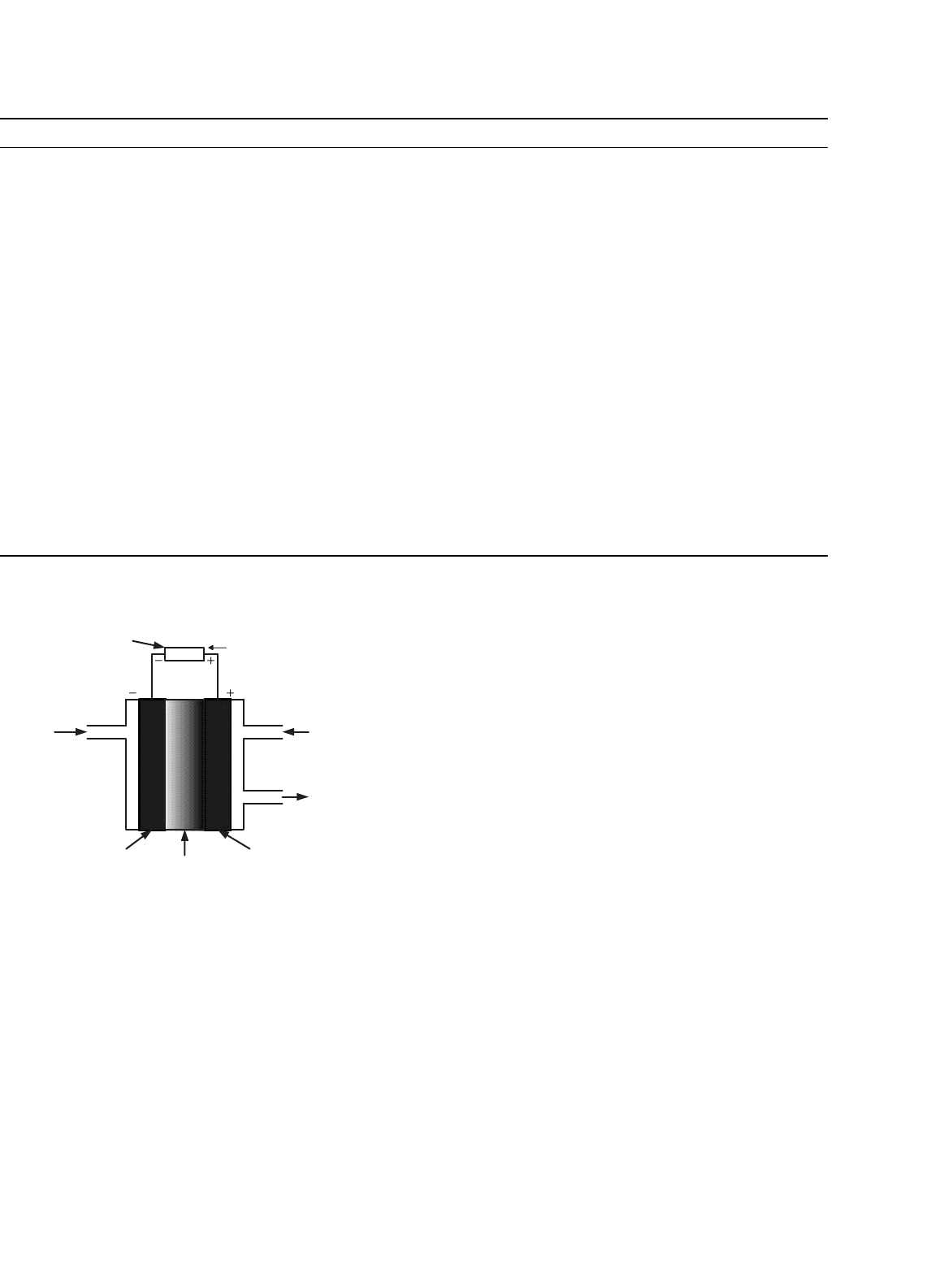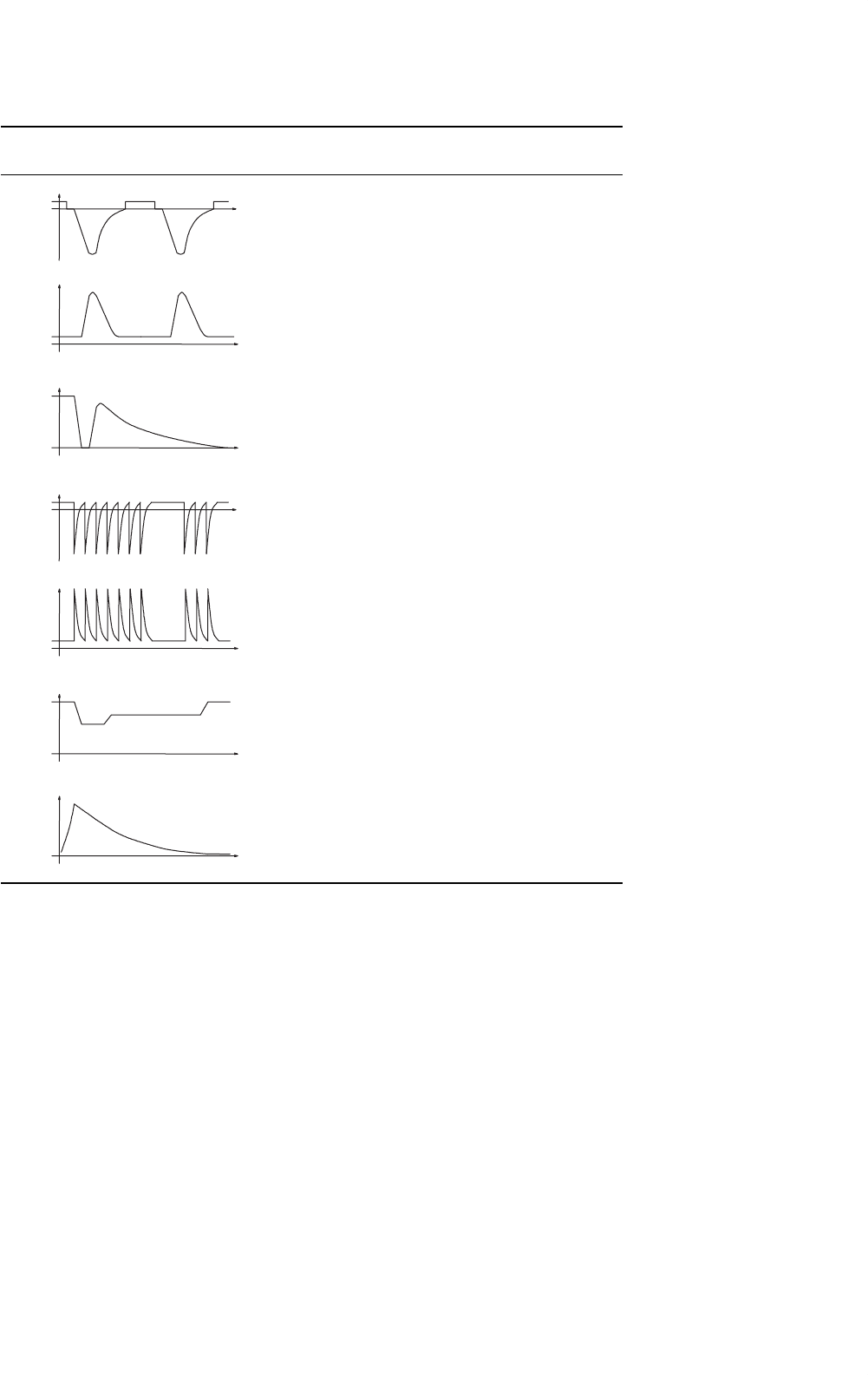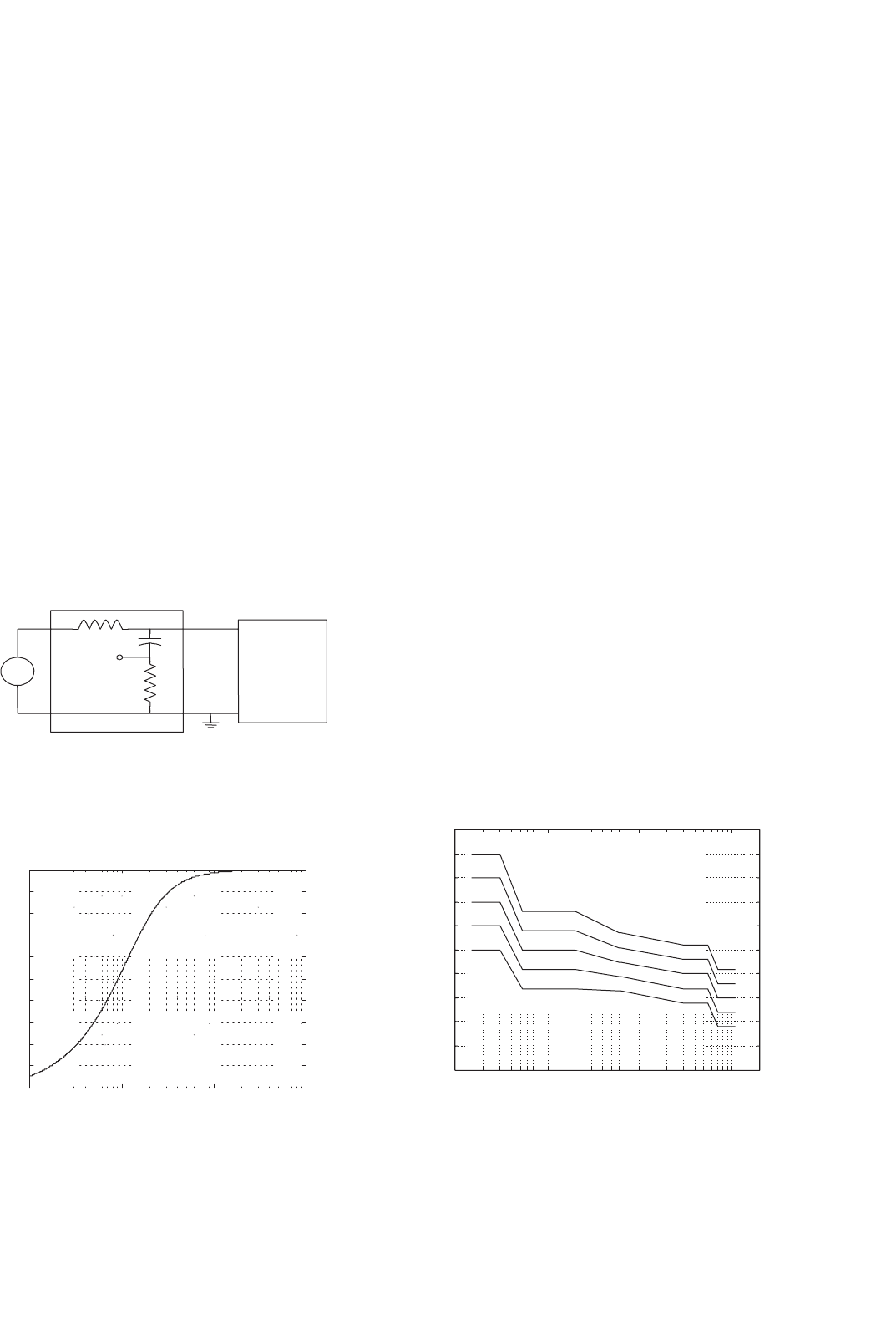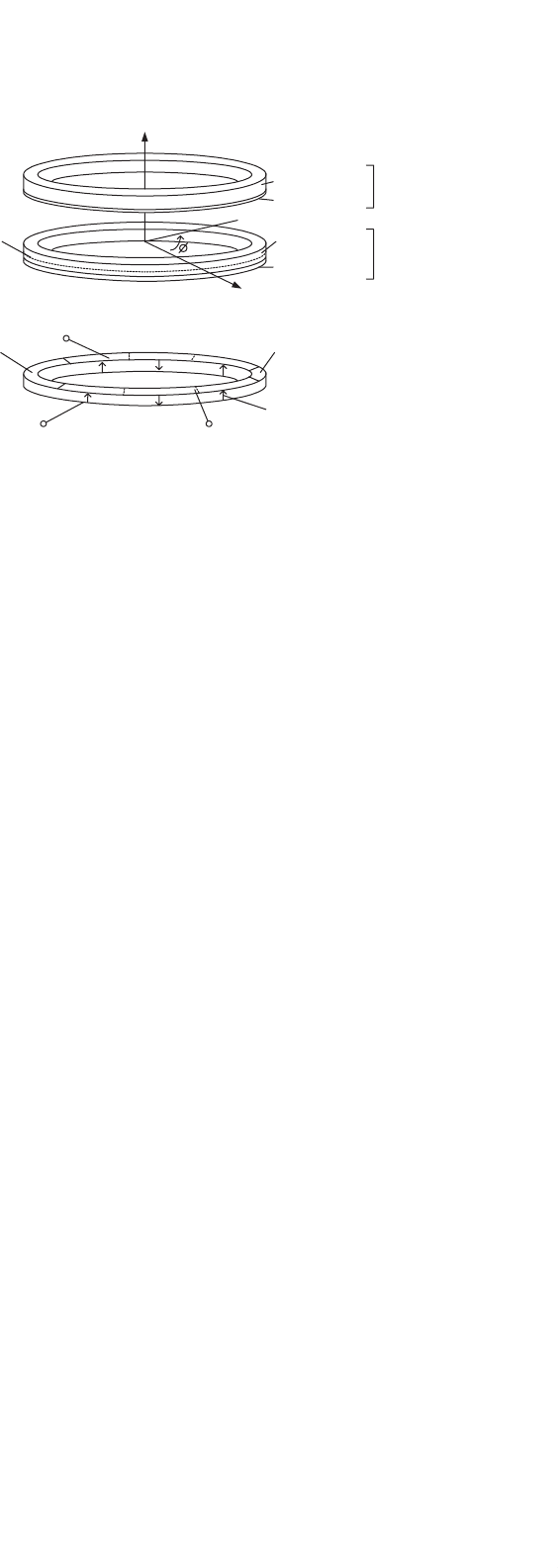Power electronic handbook
Подождите немного. Документ загружается.


632 A. Nasiri
TABLE 24.3 A comparison between different types of fuel cell system
Fuel cell type Applications Advantages Disadvantages
Proton exchange
membrane (PEM)
• Electric utility
• Portable power
• Automotive
• Solid electrolyte reduces corrosion and
management problems
• Low temperature
• Quick start-up
• Expensive catalysts
• High sensitivity to fuel impurities
Alkaline (AFC)
• Military
• Space
• High performance • Expensive removal of CO
2
from fuel and
air streams required
Phosphoric acid
(PAFC)
• Electric utility
• Automotive
• Up to 85% efficiency in cogeneration of
electricity and heat
• Can use impure H
2
as fuel
• Expensive catalysts
• Low power
• Large size/weight
Molten carbonate
(MCFC)
• Electric utility • High efficiency
• Fuel flexibility
• Can use a variety of catalysts
• High temperature enhances corrosion and
breakdown of cell components
Solid oxide fuel cell
(SOFC)
• Electric utility • High efficiency
• Fuel flexibility
• Can use a variety of catalysts
• Solid electrolyte reduces corrosion and
management problems
• Low temperature
• Quick start-up
• High temperature enhances the
breakdown of cell components
Direct alcohol fuel cell
(DAFC)
• Automotive
•
Portable power
• Compactness
•
High energy density
• Lower efficiency
•
Alcohol passing between electrodes with-
out reacting
V
LOAD
I
LOAD
ELECTRIC
LOAD
FUEL
OXIDANT
(O
2
OR AIR)
EXHAUST
ANODE
ELECTROLYTE
CATHODE
FIGURE 24.17 Configuration of a typical fuel cell system.
Further Reading
1. S. Karve, “Three of a kind,” IEE Review, vol. 46, no. 2, pp. 27–31,
March 2000.
2. R. H. Carle, “UPS applications: mill perspective,” IEEE Industry
Application Magazine, pp. 12–17, 1995.
3. R. Krishnan and S. Srinivasan, “Topologies for uninterruptible
power supplies,” in Proc. IEEE International Symposium on Industrial
Electronics, Hungary, pp. 122–127, June 1993.
4. F. Kamran and T. G. Habetler, “A novel on-line UPS with universal
filtering capabilities,” IEEE Transactions on Power Electronics, vol. 13,
no. 2, pp. 366–371, 1998.
5. J. H. Choi, J. M. Kwon, J. H. Jung, and B. H. Kwon, “High-
performance online UPS using three-leg-type converter,” IEEE
Transactions on Industrial Electronics, vol. 52, no. 3, pp. 889–897,
2005.
6. H. Pinheiro, P. K. Jain, and G. Joos, “A comparison of UPS for
powering hybrid fiber/coaxial networks,” IEEE Transactions on Power
Electronics, vol. 17, no. 3, pp. 389–397, 2002.
7. I. Youichi, I. Satoru, T. Isao, and H. Hitoshi, “New power conversion
technique to obtain high performance and high efficiency for single-
phase UPS,” in Proc. 36th IEEE Industry Applications Conference,
vol. 4, pp. 2383–2388, 2001.
8. H. Gueldner, H. Wolf, and N. Blacha, “Single phase UPS inverter
with variable output voltage and digital state feedback control,” in
Proc. IEEE International Symposium on Industrial Electronics, vol. 2,
pp. 1089–1094, 2001.
9. J. Lee, Y. Chang, and F. Liu, “A new UPS topology employing a
PFC boost rectifier cascaded high-frequency tri-port converter,” IEEE
Transactions on Industrial Electronics, vol. 46, no. 4, pp. 803–813,
1999.
10. F. Kamran and T. G. Habetler, “A novel on-line UPS with universal
filtering capabilities,” IEEE Transactions on Power Electronics, vol. 13,
no. 3, pp. 410–418, 1998.
11. B. Kwon, J. Choi, and T. Kim, “Improved single-phase line-
interactive UPS,” IEEE Transactions on Industrial Electronics, vol. 48,
no. 4, pp. 804–811, 2001.

24 Uninterruptible Power Supplies 633
12. A. Nasiri, S. Bekiarov, and A. Emadi, “Reduced parts three-phase
series-parallel UPS system with active filter capabilities,” in Proc. IEEE
38th Industry Applications Conference, vol. 2, pp. 963–969, 2003.
13. S. da Silva, P. F. Donoso-Garcia, P. C. Cortizo, and P. F. Seixas,
“A three-phase line-interactive UPS system implementation with
series-parallel active power-line conditioning capabilities,” IEEE
Transactions on Industry Applications, vol. 38, no. 6, pp. 1581–1590,
2002.
14. A. Kuskoand and S. Fairfax, “Survey of rotary uninterruptible power
supplies,” in Proc. 18th International Telecommunications Energy
Conference, pp. 416–419, 1996.
15. A. Windhorn, “A hybrid static/rotary UPS system,” IEEE Transactions
on Industry Applications, vol. 28, no. 3, pp. 541–545, 1992.
16. W. W. Hung and G. W. A. McDowell, “Hybrid UPS for standby
power systems,” Power Engineering Journal, vol. 4, no. 6, pp. 281–291,
November 1990.
17. S. R. Bowes, “Advanced regular-sampled PWM control techniques
for drives and static power converters,” IEEE Transactions on
Industrial Electronics, vol. 42, no. 4, pp. 367–373, 1995.
18. C. Rech, H. A. Grundling, and J. R. Pinheiro, “Comparison of dis-
crete control techniques for UPS applications,” in Proc. IEEE Industry
Applications Conference, pp. 2531–2537, 2000.
19. J. Chen and C. Chu, “Combination voltage-controlled and current-
controlled PWM inverters for UPS parallel operation,” IEEE Trans-
actions on Power Electronics, vol. 10, no. 5, pp. 547–558, 1995.
20. P. Mattavelli and W. Stefanutti, “Fully digital hysteresis modula-
tion with switching time prediction,” in Proc. 19th Applied Power
Electronics Conference and Exposition, pp. 493–499, 2004.
21. P. Mattavelli, “An improved deadbeat control for UPS using distur-
bance observers,” IEEE Transactions on Industrial Electronics, vol. 52,
no. 1, pp. 206–212, 2005.
22. G. E. Valderrama, A. M. Stankovic, and P. Mattavelli, “Dissipativity-
based adaptive and robust control of UPS in unbalanced operation,”
IEEE Transactions on Power Electronics, vol. 18, no. 4, pp. 1056–1062,
2003.
23. T. Tai and J. Chen, “UPS inverter design using discrete-time sliding-
mode control scheme,” IEEE Transactions on Industrial Electronics,
vol. 49, no.1, pp. 67–75, 2002.
24. U. Burup, P. N. Enjeti, and F. Blaabjerg, “A new space-vector-based
control method for UPS systems powering nonlinear and unbalanced
loads,” IEEE Transactions on Industry Applications, vol. 37, no. 6,
pp. 1864–1870, 2001.
25. N. M. Abdel-Rahim and J. E. Quaicoe, “Analysis and design of a mul-
tiple feedback loop control strategy for single-phase voltage-source
UPS inverters,” IEEE Transactions on Power Electronics, vol. 11, no. 4,
pp. 532–541, 1996.
26. A. Nasiri and A. Emadi, “Digital control of a three-phase series-
parallel uninterruptible power supply/active filter system,” in
Proc. IEEE 35th Annual Power Electronics Specialists Conference,
pp. 4115–4120, 2004.

25
Automotive Applications of Power
Electronics
David J. Perreault
Massachusetts Institute of
Technology, Laboratory for
Electromagnetic and Electronic
Systems, 77 Massachusetts
Avenue, 10-039, Cambridge
Massachusetts, USA
Khurram Afridi
Techlogix, 800 West Cummings
Park, 1925, Woburn,
Massachusetts, USA
Iftikhar A. Khan
Delphi Automotive Systems, 2705
South Goyer Road, MS D35
Kokomo, Indiana, USA
25.1 Introduction .......................................................................................... 635
25.2 The Present Automotive Electrical Power System.......................................... 636
25.3 System Environment ............................................................................... 636
25.3.1 Static Voltage Ranges • 25.3.2 Transients and Electromagnetic Immunity
• 25.3.3 Electromagnetic Interference • 25.3.4 Environmental Considerations
25.4 Functions Enabled by Power Electronics ..................................................... 641
25.4.1 High Intensity Discharge Lamps • 25.4.2 Pulse-width Modulated Incandescent Lighting
• 25.4.3 Piezoelectric Ultrasonic Actuators • 25.4.4 Electromechanical Engine Valves
• 25.4.5 Electric Air Conditioner • 25.4.6 Electric and Electrohydraulic Power Steering Systems
• 25.4.7 Motor Speed Control
25.5 Multiplexed Load Control ........................................................................ 644
25.6 Electromechanical Power Conversion ......................................................... 646
25.6.1 The Lundell Alternator • 25.6.2 Advanced Lundell Alternator Design Techniques
• 25.6.3 Alternative Machines and Power Electronics
25.7 Dual/High Voltage Automotive Electrical Systems ........................................ 652
25.7.1 Trends Driving System Evolution • 25.7.2 Voltage Specifications
• 25.7.3 Dual-voltage Architectures
25.8 Electric and Hybrid Electric Vehicles .......................................................... 655
25.9 Summary .............................................................................................. 657
References ............................................................................................. 657
25.1 Introduction
The modern automobile has an extensive electrical system
consisting of a large number of electrical, electromechanical,
and electronic loads that are central to vehicle operation, pas-
senger safety, and comfort. Power electronics is playing an
increasingly important role in automotive electrical systems –
conditioning the power generated by the alternator, processing
it appropriately for the vehicle electrical loads, and controlling
the operation of these loads. Furthermore, power electronics
is an enabling technology for a wide range of future loads with
new features and functions. Such loads include electromag-
netic engine valves, active suspension, controlled lighting, and
electric propulsion.
This chapter discusses the application and design of power
electronics in automobiles. Section 25.2 provides an overview
of the architecture of the present automotive electrical power
system. The next section, Section 25.3, describes the envi-
ronmental factors, such as voltage ranges, EMI/EMC require-
ments, and temperature, which strongly influence the design of
automotive power electronics. Section 25.4 discusses a number
of electrical functions that are enabled by power electron-
ics, while Section 25.5 addresses load control via multiplexed
remote switching architectures that can be implemented with
power electronic switching. Section 25.6 considers the appli-
cation of power electronics in automotive electromechanical
energy conversion, including power generation. Section 25.7
describes the potential evolution of automotive electrical sys-
tems towards high- and dual-voltage systems, and provides
an overview of the likely requirements of power electronics in
such systems. Finally, the application of power electronics in
electric and hybrid electric vehicles is addressed in Section 25.8.
635
Copyright © 2001 by Academic Press

636 D. J. Perreault et al.
Alternator Battery
Fusebox
Primary
Switches
Loads
Relay
FIGURE 25.1 The 12-V point-to-point automotive electrical power system.
25.2 The Present Automotive Electrical
Power System
Present-day automobiles can have over 200 individual elec-
trical loads, with average power requirements in excess of
800 W. These include such functions as the headlamps, tail
lamps, cabin lamps, starter, fuel pump, wiper, blower fan, fuel
injector, transmission shift solenoids, horn, cigar lighter, seat
heaters, engine control unit, cruise control, radio, and spark
ignition. To power these loads, present day internal combus-
tion engine (ICE) automobiles use an electrical power system
similar to the one shown in Fig. 25.1. Power is generated
by an engine-driven three-phase wound-field synchronous
machine – a Lundell (claw-pole) alternator [1, 2]. The ac
voltage of this machine is rectified and the dc output regu-
lated to about 14 V by an electronic regulator that controls the
field current of the machine. The alternator provides power
to the loads and charges a 12 V lead-acid battery. The battery
provides the high power needed by such loads as the starter,
and supplies power when the engine is not running or when
the demand for electrical power exceeds the output power of
the alternator. The battery also acts as a large capacitor and
smoothes out the system voltage.
Power is distributed to the loads via fuses and point-to-point
wiring. The fuses, located in one or more fuseboxes, protect
the wires against overheating and fire in the case of a short.
Most of the loads are controlled directly by manually actuated
mechanical switches. These primary switches are located in
areas in easy reach of either the driver or the passengers, such
as the dashboard, door panels, and the ceiling. Some of the
heavy loads, such as the starter, are switched indirectly via
electromechanical relays.
25.3 System Environment
The challenging electrical and environmental conditions found
in the modern automobile have a strong impact on the design
of automotive power electronic equipment. Important factors
affecting the design of electronics for this application include
static and transient voltage ranges, electromagnetic interfer-
ence and compatibility requirements (EMI/EMC), mechanical
vibration and shock, and temperature and other environmen-
tal conditions. This section briefly describes some of the factors
that most strongly affect the design of power electronics for
automotive applications. For more detailed guidelines on the
design of electronics for automotive applications, the reader is
referred to [1, 3–16] and the documents cited therein, from
which much of the information presented here is drawn.
25.3.1 Static Voltage Ranges
In most present-day automobiles, a Lundell-type alternator
provides dc electrical power with a lead-acid battery for energy
storage and buffering. The nominal battery voltage is 12.6 V,
which the alternator regulates to 14.2 V when the engine
is on in order to maintain a high state of charge on the
battery. In practice, the regulation voltage is adjusted for
temperature to match the battery characteristics. For exam-
ple, in [1], a 25
◦
C regulation voltage of 14.5 V is specified
with a −10 mV/
◦
C adjustment. Under normal operating con-
ditions, the bus voltage will be maintained in the range of
11–16 V [3]. Safety-critical equipment is typically expected to
be operable even under battery discharge down to 9 V, and
equipment operating during starting may see a bus voltage as
low as 4.5–6 V under certain conditions.
In addition to the normal operating voltage range, a wider
range of conditions is sometimes considered in the design of
automotive electronics [3]. One possible condition is reverse-
polarity battery installation, resulting in a bus voltage of
approximately −12 V. Another static overvoltage condition
can occur during jump starting from a 24-V system such as on
a tow truck. Other static overvoltage conditions can occur due
to failure of the alternator voltage regulator. This can result in a
bus voltage as high as 18 V, followed by battery electrolyte boil-
off and a subsequent unregulated bus voltage as high as 130 V.
Typically, it is not practical to design the electronics for oper-
ation under such an extreme fault condition, but it should
be noted that such conditions can occur. Table 25.1 summa-
rizes the range of static voltages that can be expected in the
automotive electrical system.

25 Automotive Applications of Power Electronics 637
TABLE 25.1 Static voltage range for the automotive
electrical system [3]
Static voltage condition Voltage
Nominal voltage with engine on 14.2 V
Nominal voltage with engine off 12.6 V
Maximum normal operating voltage 16 V
Minimum normal operating voltage 9 V
Minimum voltage during starting 4.5 V
Jump start voltage 24 V
Reverse battery voltage −12 V
Maximum voltage with alternator regulator
failure followed by battery failure
130 V
25.3.2 Transients and Electromagnetic
Immunity
Power electronic circuits designed for automotive applications
must exhibit electromagnetic compatibility, i.e. the conducted
and radiated emissions generated by the circuit must not
interfere with other equipment on board the vehicle, and the
circuit must exhibit immunity to radiated and conducted dis-
turbances. The Society of Automotive Engineers (SAE) has
laid out standards and recommended practices for the elec-
tromagnetic compatibility of automotive electronics in a set
of technical reports [4]. These reports are listed in Table 25.2.
Here we will focus on two of the basic requirements of auto-
motive power electronics: immunity to power lead transients
and limitation of conducted emissions.
A major consideration in the design of an automotive power
electronic system is its immunity to the transients that can
appear on its power leads. A number of transient sources exist
in the vehicle [5] and procedures for validating immunity to
these transients have been established in documents such as
TABLE 25.2 SAE J1113 electromagnetic compatibility technical reports
SAE specification Type Description
SAE J1113/1 Standard Electromagnetic compatability measurement procedures and limits, 60 Hz–18 GHz
SAE J1113/2 Standard Conducted immunity, 30 Hz–250 kHz
SAE J1113/3 Standard Conducted immunity, direct injection of RF power, 250 kHz–500 MHz
SAE J1113/4 Standard Conducted immunity, bulk current injection method
SAE J1113/11 Standard Conducted immunity to power lead transients
SAE J1113/12 Recommended practice Electrical interference by conduction and coupling – coupling clamp
SAE J1113/13 Recommended practice Immunity to electrostatic discharge
SAE J1113/21 Information report Electrical disturbances by narrowband radiated electromagnetic energy – component test methods
SAE J1113/22 Standard Immunity to radiated magnetic fields from power lines
SAE J1113/23 Recommended practice Immunity to radiated electromagnetic fields, 10 kHz–200 MHz, strip line method
SAE J1113/24 Immunity to radiated electromagnetic fields, 10 kHz–200 MHz, TEM cell method
SAE J1113/25 Standard Immunity to radiated electromagnetic fields, 10 kHz–500 MHz, tri-plate line method
SAE J1113/26 Recommended practice Immunity to ac power line electric fields
SAE J1113/27 Recommended practice Immunity to radiated electromagnetic fields, reverberation method
SAE J1113/41 Standard Radiated and conducted emissions, 150 kHz–1000 MHz
SAE J1113/42 Standard Conducted transient emissions
SAE J1113/11 [4, 6] and DIN 40389 [1]. Table 25.3 illustrates
the transient test pulses specified in SAE J1113/11. Each test
pulse corresponds to a different type of transient. The vehicle
manufacturer determines which test pulses apply to a specific
device.
Transients occur when inductive loads such as solenoids,
motors, and clutches are turned on and off. The transients can
be especially severe when the bus is disconnected from the bat-
tery, as is the case for the accessory loads when the ignition is
switched off. Test pulse 1 in Table 25.3 simulates the transient
generated when an inductive load is disconnected from the
battery and the device under test remains in parallel with it.
When the inductive load is a dc motor, it may briefly act as
a generator after disconnection. This transient is simulated by
test pulse 2b. Test pulse 2a models the transient when current
in an inductive element in series with the device under test
is interrupted. Test pulses 3a and 3b model switching spikes
that appear on the bus during normal operation. Test pulse 4
models the voltage transient that occurs on starting.
Perhaps the best-known electrical disturbance is the
so-called load dump transient that occurs when the alternator
load current drops sharply and the battery is unable to properly
buffer the change. This can occur when the battery becomes
disconnected while drawing a large amount of current. To
understand why a major transient can occur under this sit-
uation, consider that the Lundell-alternator has a very large
leakage reactance. The high commutating reactance interacting
with the diode rectifier results in a high degree of load regula-
tion, necessitating the use of a large back emf to source rated
current at high speed [7]. Back voltages as high as 120 V may
be needed to generate rated current into a 14 V output at top
speed. Analytical modeling of such systems is addressed in [8].
Two effects occur when the load on the alternator suddenly
steps down. First, as the machine current drops, the energy in

638 D. J. Perreault et al.
TABLE 25.3 Transient pulse waveforms specified in SAE J1113/11
Pulse Shape Maximum excursion Source impedance Duration and
repetition rate
1
t
v
−100 V 10 T
pulse
= 2ms
0.5 s < T
rep
< 5s
2a
t
v
100 V 10 T
pulse
= 50 µs
0.5 s < T
rep
< 5s
2b
t
v
10 V 0.5–3 T
pulse
≥ 200 ms
3a
t
v
−150 V 50 T
pulse
= 100 ns
T
rep
= 100 µs
3b
v
t
100 V 50 T
pulse
= 100 ns
T
rep
= 100 µs
4
v
t
−7 V 0.01 T
pulse
≤ 20 s
5
i
t
84 A 0.6 τ= 115 ms
T
pulse
∼ 4τ
the alternator leakage reactances is immediately delivered to
the alternator output, causing a voltage spike. The peak voltage
reached depends on the electrical system impedance, and may
be limited by suppression devices. Second, once the alternator
current is reduced, the voltage drops across the leakage (com-
mutating) reactances are reduced, and a much larger fraction
of the machine back-emf is impressed across the dc output.
The proper output voltage is only re-established as the voltage
regulator reduces the field current appropriately. With conven-
tional regulator circuits, this takes place on the time scale of
the field winding time constant (typically 100 ms), and results
in a major transient event. In systems without centralized
protection, a load dump can generate a transient with a peak
voltage in excess of 100 V lasting hundreds of milliseconds.
Test pulse 5 in Table 25.3 (expressed as a current waveform
in parallel with an output resistance) is designed to simulate
such a load-dump transient; other load-dump tests are even
more severe [1, 3].
25.3.3 Electromagnetic Interference
Strict limits also exist for the amount of electromagnetic inter-
ference (EMI) that an automotive electronic component can
generate. Limits for both conducted and radiated emissions are

25 Automotive Applications of Power Electronics 639
specified in SAE standards J1113/41 and J1113/42 [4, 9, 10].
Here we will consider the conducted EMI specifications for
power leads, since they directly impact the design of EMI
filters for automotive power electronics. Meeting the con-
ducted specifications is a major step towards achieving overall
compliance.
The conducted EMI specifications in SAE J1113/41 limit
the ripple that an electronic circuit can inject onto the voltage
bus over the frequency range from 150 KHz to 108 MHz. The
amount of ripple injected by a circuit usually depends on the
bus impedance. To eliminate any variability due to this, EMI
compliance testing is done using a line impedance stabiliza-
tion network (LISN) between the bus and the device under
test, as illustrated in Fig. 25.2. The LISN is also sometimes
referred to as an artificial mains network (AN). Essentially,
the LISN ensures that the equipment under test receives the
proper dc voltage and current levels and also sees a controlled
impedance for the ripple frequencies of interest. Figure 25.3
shows the magnitude of the LISN output impedance for a low-
impedance input source; the effective impedance is 50 over
most of the frequency range of interest. The 50- termination
impedance of the LISN is typically provided by the measure-
ment equipment. The EMI specifications are stated in terms of
LISN
V
IN
V
LISN
Equipment
Under
Test
++
–
–
FIGURE 25.2 Conducted EMI test set up with LISN. L
LISN
= 5 µH,
C
LISN
= 0.1 µF, and R
LISN
= 50 .
¸z¸ (Ohms)
10
5
10
6
10
7
10
8
0
5
10
15
20
25
30
35
40
45
50
Frequency (Hz)
LISN Output Impedance Magnitude
FIGURE 25.3 The LISN output impedance magnitude for a low
impedance input source.
the allowable voltage ripple (in dB µV) appearing across the
50- LISN resistance as a function of frequency.
There are a wide range of other technical considerations for
EMI testing, including the arrangement of the equipment over
a ground plane and the types and settings of the measuring
devices. One characteristic to consider is that the EMI mea-
surements are done across frequency with a spectrum analyzer
having a prespecified receiver bandwidth (RBW). For frequen-
cies between 150 kHz and 30 MHz, the receiver bandwidth is
9 kHz, resulting in spectral components within 9 kHz of one
another being lumped together for purposes of the test. A full
test procedure is defined in the SAE specifications, beginning
with narrowband measurements and moving to wideband
measurements if necessary. Figure 25.4 illustrates the narrow-
band conducted EMI limits for power leads in SAE J1113/41.
It is interesting to note that for the commonly used Class 5
limits, the allowable ripple current into the LISN at 150 kHz is
less than 100 µA!
As seen in the previous section, the transient disturbances
generated by electrical and electronic equipment are an impor-
tant consideration in automotive applications. Because power
electronic circuits typically contain switches and magnetic ele-
ments, they are potential sources for such transients, especially
when powered from the switched ignition line. SAE J1113/42
specifies methods for testing and evaluating the transients gen-
erated by automotive electrical components, and proposes
transient waveform limits for different severity levels. The
equipment under test is set up in a configuration similar to
that in Fig. 25.2, but with a switching device on one side or the
other of the LISN, depending on the application. The equip-
ment under test is then evaluated for transient behavior at
turn on, turn off, and across its operating range. The voltage
transients at the input of the equipment are measured and
10
5
10
6
10
7
10
8
0
10
20
30
40
50
60
70
80
90
100
Frequency (Hz)
SAE J1113/41 Power Lead Narrow Band Conducted EMI Limits
Class 5
Class 4
Class 3
Class 2
Class 1
EMI limit (dB µV)
FIGURE 25.4 SAE J1113/41 narrowband conducted EMI limits for
power leads. The specification covers the frequency range from 150 kHz
to 108 MHz.

640 D. J. Perreault et al.
evaluated with respect to magnitude, duration, and rise and
fall times. Specific limits for such transients are specified by
the vehicle manufacturer, but SAE J1113/42 proposes a rep-
resentative set of limits for four different transient severity
levels.
Due to the tight conducted emissions limits, input EMI fil-
ter design is an important consideration in automotive power
electronics. Single or multistage low-pass filters are typically
used to attenuate converter ripple to acceptable levels [11–13].
When designing such filters, the parasitic behavior of the filter
components, such as capacitor equivalent series resistance and
inductance, and suitable filter damping are important consid-
erations [14]. One must also ensure that the filter design yields
acceptable transients at switch on and off, and does not result
in undesired dynamic interactions with the power circuit [13].
Attention to appropriate filter design, coupled with proper cir-
cuit layout, grounding, and shielding goes a long way towards
meeting electromagnetic interference specifications [14].
25.3.4 Environmental Considerations
The automobile is a very challenging environment for elec-
tronics. Environmental factors influencing the design of auto-
motive electronics include temperature, humidity, mechanical
shock, vibration, immersion, salt spray, and exposure to sand,
gravel, oil, and other chemicals. In 1978, the SAE developed
a recommended practice for electronic equipment design to
address these environmental considerations [3, 4]. This doc-
ument, SAE J1211, provides quantitative information about
the automotive environment to aid the designer in developing
environmental design goals for electronic equipment. Here, we
briefly summarize a few of the most important factors affecting
the design of power electronics for automotive applications.
For more detailed guidelines, the reader is referred to [3] and
the documents cited therein.
Perhaps the most challenging environmental characteristic
is the extreme range of temperatures that can occur in the
automobile. Table 25.4 summarizes some of the temperature
extremes listed in SAE J1211 for different locations in the auto-
mobile. Ambient temperatures as low as −40
◦
C may be found
during operation, and storage temperatures as low as −50
◦
C
may be found for components shipped in unheated aircraft.
Maximum ambient temperatures vary widely depending on
vehicle location, even for small differences in position. Because
ambient temperature has a strong impact on the design of a
power electronic system it is important to work closely with the
vehicle manufacturer to establish temperature specifications
for a particular application. For equipment that is air-cooled,
one must also consider that the equipment may be operated at
altitudes up to 12,000 feet above sea level. This results in low
ambient pressure (down to 9 psia), which can reduce the heat
transfer efficiency [3]. For equipment utilizing the radiator-
cooling loop, maximum coolant temperatures in the range of
105–120
◦
C at a pressure of 1.4 bar are possible [15].
TABLE 25.4 Automotive temperature extremes by location [3]
Vehicle location Min temp. (
◦
C) Max temp. (
◦
C)
Exterior −40 85
Chassis
Isolated −40 85
Near heat source −40 121
Drive train high temperature
location
−40 177
Interior
Floor −40 85
Rear deck −40 104
Instrument panel −40 85
Instrument panel top −40 177
Trunk −40 85
Under hood
Near radiator support
structure
−40 100
Intake manifold −40 121
Near alternator −40 131
Exhaust manifold −40 649
Dash panel (normal) −40 121
Dash panel (extreme) −40 141
In addition to the temperature extremes in the automobile,
thermal cycling and shock are also important considerations
due to their effect on component reliability. Thermal cycling
refers to the cumulative effects of many transitions between
temperature extremes, while thermal shock refers to rapid
transitions between temperature extremes, as may happen
when a component operating at high temperature is sud-
denly cooled by water splash. The damaging effects of thermal
cycling and shock include failures caused by thermal expansion
mismatches between materials. Test methods have been devel-
oped which are designed to expose such weaknesses [3, 16].
The thermal environment in the automobile, including the
temperature extremes, cycling, and shock, are challenging
issues that must be addressed in the design of automotive
power electronics.
A number of other important environmental factors exist
in the automobile. Humidity levels as high as 98% at 38
◦
C
can exist in some areas of the automobile, and frost can
occur in situations where the temperature drops rapidly.
Salt atmosphere, spray, water splash, and immersion are also
important factors for exterior, chassis, and underhood com-
ponents. Failure mechanisms resulting from these factors
include corrosion and circuit bridging. Dust, sand, and gravel
bombardment can also be significant effects depending on
equipment location. Mechanical vibration and shock are also
important considerations in the design of automotive power
electronic equipment. Details about the effects of these envi-
ronmental factors, sample recorded data, and recommended
test procedures can be found in [3].

25 Automotive Applications of Power Electronics 641
25.4 Functions Enabled by Power
Electronics
Over the past 20 years, power electronics has played a major
role in the introduction of new functions such as the antilock
breaking system (ABS), traction control, and active suspen-
sion, as well as the electrification of existing functions such
as the engine-cooling fan, in the automobile. This trend is
expected to continue, as a large number of new features being
considered for introduction into automobiles require power
electronics. This section discusses some of the new functions
that have been enabled by power electronics, and some existing
ones that benefit from it.
25.4.1 High Intensity Discharge Lamps
High intensity discharge (HID) lamps have started to appear
in automobiles as low-beam headlights and fog lights. The
HID lamps offer higher luminous efficacy, higher reliability,
longer life, and greater styling flexibility than the traditional
halogen lamps [17, 18]. The luminous efficacy of an HID
lamp is over three times that of a halogen lamp and its life is
about 2000 hours, compared to 300–700 hours for a halogen
lamp. Therefore, HID lamps provide substantially higher road
illumination while consuming the same amount of electrical
power and, in most cases, should last the life of the automo-
bile. The HID lamps also produce a whiter light than halogen
lamps since their color spectrum is closer to that of the sun.
High intensity discharge lamps do not have a filament.
Instead, light is generated by discharging an arc through a
pressurized mixture of mercury, xenon, and vaporized metal
halides – mercury produces most of the light, the metal halides
determine the color spectrum, and xenon helps reduce the
start-up time of the lamp [17, 19]. Unlike halogen lamps that
can be powered directly from the 12-V electrical system, HID
lamps require power electronic ballasts for their operation.
Initially, a high voltage pulse of 10–30 kV is needed to ignite
the arc between the electrodes and a voltage of about 85 V is
needed to sustain the arc [4.3]. Figure 25.5 shows a simplified
power electronic circuit that can be used to start and drive
an HID lamp. A step-up dc–dc converter is used to boost the
HID
lamp
12 V
Starter
H-bridgeBoost converter
FIGURE 25.5 Simplified power electronic circuit for an HID lamp ballast.
voltage from 12 V to the voltage needed for the steady-state
operation of the HID lamp. Any dc–dc converter that can step
up the voltage, such as the boost or flyback converter, can be
used for this application. An H-bridge is then used to create
the ac voltage that drives the lamp in steady state. The circuit
to initiate the arc can be as simple as a circuit that provides an
inductive voltage kick, as shown in Fig. 25.5.
25.4.2 Pulse-width Modulated Incandescent
Lighting
Future automobiles may utilize a 42 V electrical system in place
of today’s 14 V electrical system (see Section 25.7). Because
HID lamps are driven through a power electronic ballast, HID
lighting systems operable from a 42 V bus can be easily devel-
oped. However, the high cost of HID lighting – as much as an
order of magnitude more expensive than incandescent light-
ing – largely limits its usefulness to headlight applications.
Incandescent lamps compatible with 42 V systems can also be
implemented. However, because a much longer, thinner fila-
ment must be employed at the higher voltage, lamp lifetime
suffers greatly. An alternative to this approach is to use pulse-
width modulation to operate 12 V incandescent lamps from a
42 V bus [20].
In a pulse-width modulated (PWM) lighting system, a semi-
conductor switch is modulated to apply a periodic pulsed
voltage to the lamp filament. Because of its resistive nature,
the power delivered to the filament depends on the rms of the
applied voltage waveform. The thermal mass of the system fil-
ters the power pulsations so that the filament temperature and
light production are similar to that generated by a dc voltage
with the same rms value. The PWM frequency is selected low
enough to avoid lamp mechanical resonances and the need for
EMI filtering, while being high enough to limit visible flicker;
PWM frequencies in the range of 90–250 Hz are typical [20].
Ideally, a 11.1% duty ratio is needed to generate 14 V rms
across a lamp from a 42 V nominal voltage source. In practice,
deviations from this duty ratio are needed to adjust for input
voltage variations and device drops. In some proposed systems,
multiple lamps are operated within a single lighting module
with phase staggered (interleaved) PWM waveforms to reduce
the input rms current of the module.

642 D. J. Perreault et al.
Another issue with PWM lighting relates to startup. Even
with operation from a 12 V dc source, incandescent lamps have
an inrush current that is 6–8 times higher than the steady-
state value, because of how filament resistance changes with
temperature; this inrush impacts lamp durability. The addi-
tional increase in peak inrush current due to operating from
a 42 V source can be sufficient to cause destruction of the
filament, even when using conventional PWM soft-start tech-
niques (a ramping up of duty ratio). Means for limiting the
peak inrush current – such as operating the controlling MOS-
FET in current limiting mode during startup – are needed to
make practical use of PWM lighting control.
While PWM incandescent lighting technology is still in the
early stages of development, it offers a number of promis-
ing advantages in future 42 V vehicles. These include low-cost
adaptation of incandescent lighting to high-voltage systems,
control of lighting intensity independent of bus voltage, the
ability to implement multiple intensities, flashing, dimming,
etc. through PWM control, and the potential improvement of
lamp durability through more precise inrush and operating
control [20].
25.4.3 Piezoelectric Ultrasonic Actuators
Piezoelectric ultrasonic motors are being considered as actu-
ators for window lifts, seat positioning, and head restraints
in automobiles [21, 22]. These motors work on the principle
of converting piezoelectrically induced ultrasonic vibrations
in an elastic body into unidirectional motion of a moving
part. Unidirectional motion is achieved by allowing the vibrat-
ing body to make contact with the moving part only during
a half-cycle of its oscillation, and power is transferred from
the vibrating body to the moving part through frictional
contact. Ultrasonic motors have a number of attractive fea-
tures, including high-torque density, large holding torque even
without input power, low speed without gears, quiet opera-
tion, no magnetic fields, and high dynamics [21, 23]. These
characteristics make ultrasonic motors an attractive alterna-
tive to electromagnetic motors for low-power high-torque
applications.
Various types of ultrasonic motors have been developed.
However, because of its compact design, the traveling wave
type is the most popular ultrasonic motor [24]. Figure 25.6a
shows the basic structure of such a motor. It consists of a
metal stator and rotor, which are pushed against each other
by a spring. The rotor is coated with a special lining material
to increase friction and reduce wear at the contacting surfaces.
A layer of piezoelectric material, such as lead zirconate titanate
(PZT), is bonded to the underside of the stator. Silver elec-
trodes are printed on both sides of the piezoceramic ring. The
top electrode is segmented and the piezoceramic is polarized
as shown in Fig. 25.6b. The number of segments is twice the
order of the excited vibration mode.
z
metal ring
metal ring
lining material
rotor
piezoelectric
ceramic
stator
(a)
r
(b)
spacer
segment
spacer
segment
B
C
A
poling
direction
neutral plane
FIGURE 25.6 (a) Basic structure of a traveling wave piezoelectric ultra-
sonic motor and (b) structure of the piezoceramic ring and electrode
for a four-wavelength motor. Arrows indicate direction of polarization.
Dashed lines indicate segments etched in the electrode for poling but
electrically connected during motor operation.
When a positive voltage is applied between terminals A
and C, the downwards poled segment elongates and the
upwards poled segments contract. This causes the stator to
undulate, waving down at the elongated section and up at the
contracted one. When the polarity of the voltage is inverted,
the undulations are also inverted. Hence, when an ac voltage is
applied a flexural standing wave is created in the stator. To get a
large wave amplitude, the stator is driven at the resonance fre-
quency of the flexural mode. An ac voltage between terminals
B and C similarly produces another standing wave. However,
because of the spacer segments in the piezoceramic ring, the
second standing wave is 90
◦
spatially out of phase from the first
one. If the two standing waves are excited by ac voltages that
are out of phase in time by 90
◦
, a traveling wave is generated.
As the traveling wave passes through a point along the neu-
tral plane, that points simply exhibits axial (z-axis) motion.
However, off-neutral plane points also have an azimuthal
(φ-axis) component of motion. This azimuthal motion of the
surface points propels the rotor. Ultrasonic motors require a
power electronic drive. A power electronic circuit suitable for
driving an ultrasonic motor is shown in Fig. 25.7. The two
H-bridges are controlled to generate waveforms that are 90
◦
out of phase with each other.
25.4.4 Electromechanical Engine Valves
Electromagnetic actuators are finding increasing application in
automotive systems. These actuators are more desirable than
the other types of actuators, such as the hydraulic and pneu-
matic actuators, because they can be more easily controlled by
a microprocessor to provide more precise control. An applica-
tion of electromagnetic actuators that is of particular interest
is the replacement of the camshaft and tappet valve assembly
